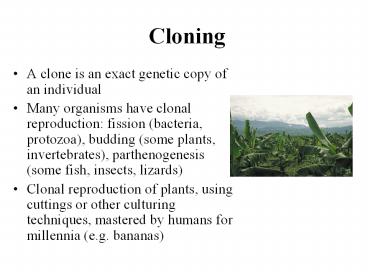Cloning - PowerPoint PPT Presentation
1 / 18
Title:
Cloning
Description:
... parthenogenesis (some fish, insects, lizards) ... The whiptail lizard is a parthenogenic species that formed as a hybrid of two other species. ... – PowerPoint PPT presentation
Number of Views:64
Avg rating:3.0/5.0
Title: Cloning
1
Cloning
- A clone is an exact genetic copy of an individual
- Many organisms have clonal reproduction fission
(bacteria, protozoa), budding (some plants,
invertebrates), parthenogenesis (some fish,
insects, lizards) - Clonal reproduction of plants, using cuttings or
other culturing techniques, mastered by humans
for millennia (e.g. bananas)
2
Asexual Organisms
A few species, like this gecko, are
parthenogenic. This means that all individuals
are female, and their offspring are exact genetic
copies of themselves, or clones.
3
Asexual Organisms
Most asexual species have close relatives that
are sexual. The whiptail lizard is a
parthenogenic species that formed as a hybrid of
two other species. It tricks males of the other
species to mate with it, because it needs sperm
to activate its eggs
4
Cloning
- Vertebrate cloning difficult especially mammals
birds - Dolly was 1of 276 attempts
- Current technology
- Harvest the nucleus of a cell from an adult
- Inject it into an egg cell that has had its
nucleus removed - Make sure that cells begin to divide normally (an
embryo begins to form) This is the hard step - Place the developing embryo in a foster mother
5
(No Transcript)
6
Cloning
- Cloning (potentially) permits the rapid,
economical reproduction of individuals with
desirable traits - With serial cloning, genetic lines can be
preserved (almost) exactly - Serial cloning may destabilize chromosomes
- Mutations will accumulate a cost of clonal
reproduction - Even though the nucleus of the egg is removed,
some of the egg-donors genes remain, in the
mitochondria thus the first generation is not a
perfect clone - Long term risk in terms of lost genetic diversity
- More vulnerable to disease epidemics
- Less variation to adapt to environmental change
7
Gene Therapies
- Introduce substances that halt the activity of
certain genes (AZT) - Introduce substances that (over) promote activity
of certain genes (gamma globin) - Introduce new, functional genes true Gene Therapy
- Experimental, currently tested primarily on
critically ill patients
8
Gene Therapy
- Vehicle or Vector
- e.g. weakened virus
- Recipient cells
- cultured cells or in vivo somatic cells e.g bone
marrow - The introduced sequence
- Marker (so you know it worked)
- Promoter (to cause transcription)
- The Gene
9
The Problems
- Must immuno-suppress the patient
- Efficiency of transfer often low
- Duration of expression often short
- Unknown risks permanent unwanted changes
(mutations) to somatic (or germ cells), viral
infections, cancer or other diseases associated
with breakdown in genetic regulation?
10
Genetically Modified (Transgenic) Crops
- 50 of soybeans, 25 of corn grown in the US are
transgenic (have a gene from another species
added via biotech) - Main transgenic traits herbicide tolerance, Bt
toxins to kill insect pests, virus resistance - Future transgenic traits vitamins, vaccines
(inactivated viruses) - Potential to reduce uses of agrochemicals,
increase food production, improve quality of
plant products (including novel ones)
11
Genetically Modified (Transgenic) Crops
- Using specialized enzymes, chop up gene
sequences, select and connect desirable sequences
to form a cassette - Sequence must include a marker, promoter,
transgene - Flanked by sticky ends
- Infect a bacteria (E. coli) to produce quantities
of cassettes via bacterial clonal reproduction - Purify sequences, inject sequences into cells
- Gene gun
- Infective bacteria
- Select plant cells with the marker
- Propagate selected plants clonally
- Produce new plants clonally or through sexual
crosses
12
(No Transcript)
13
(No Transcript)
14
Problems with Transgenic Crops
- Doesnt work very well - yet
- Risk of traits spreading to weeds, producing
super weeds, or pests developing resistance to
transgenic defenses - Risk to non-target organisms
- No unusual health risks (?), requires strict
testing - Reduced genetic diversity puts crops at (long
term) risk - Agricultural resources become monopolized by a
small number of gigantic agrobusinesses
15
Transgenic Animals
- Potentially quite useful
- Animal models of human diseases by introducing
human genes - Targeted production of pharmaceutical proteins
(human enzymes, hormones, growth factors) - Modification of animal anatomy physiology
16
Transgenic Animals
- Create cassette enhancer promoter gene
plus sticky ends - Enhancer often designed to restrict activation of
the gene to a targeted tissue (e.g liver) only - Infect a bacteria (E. coli) to amplify the
cassettes via bacterial clonal reproduction - Collect and purify the cassettes, test for
activation in eukaryotic cells - Inject cassettes into a newly fertilized egg
cells - Transfer embryos into a surrogate mother
- Analyze babies, breed or reproduce clones of
those that express the transgene and have the
fewest other problems
17
(No Transcript)
18
Problems with Transgenic Animals
- Doesnt work very well yet
- Cassettes integrate randomly into genome,
sometimes knocking out genes - Sometimes multiple copies integrate
- Integration not always stable
- Same worries as transgenic crops
- Animal welfare

